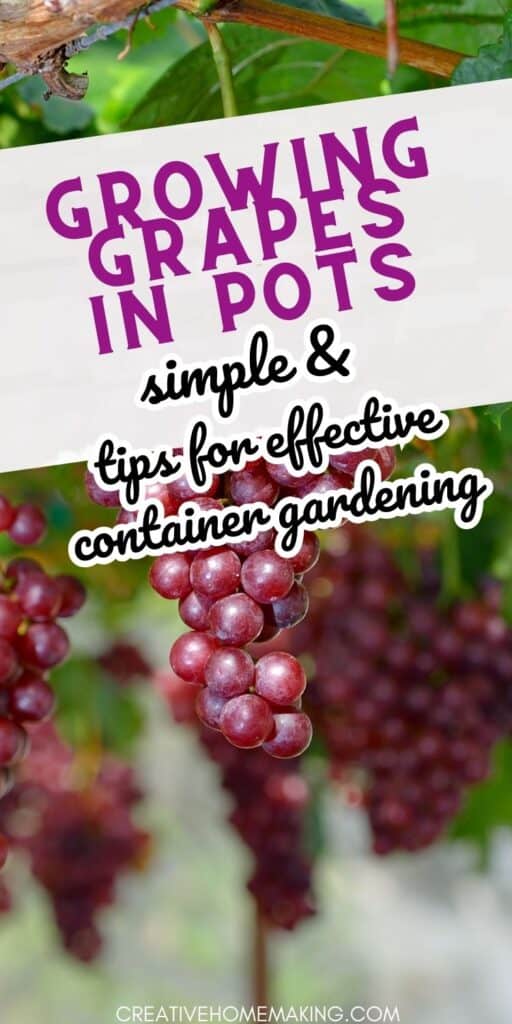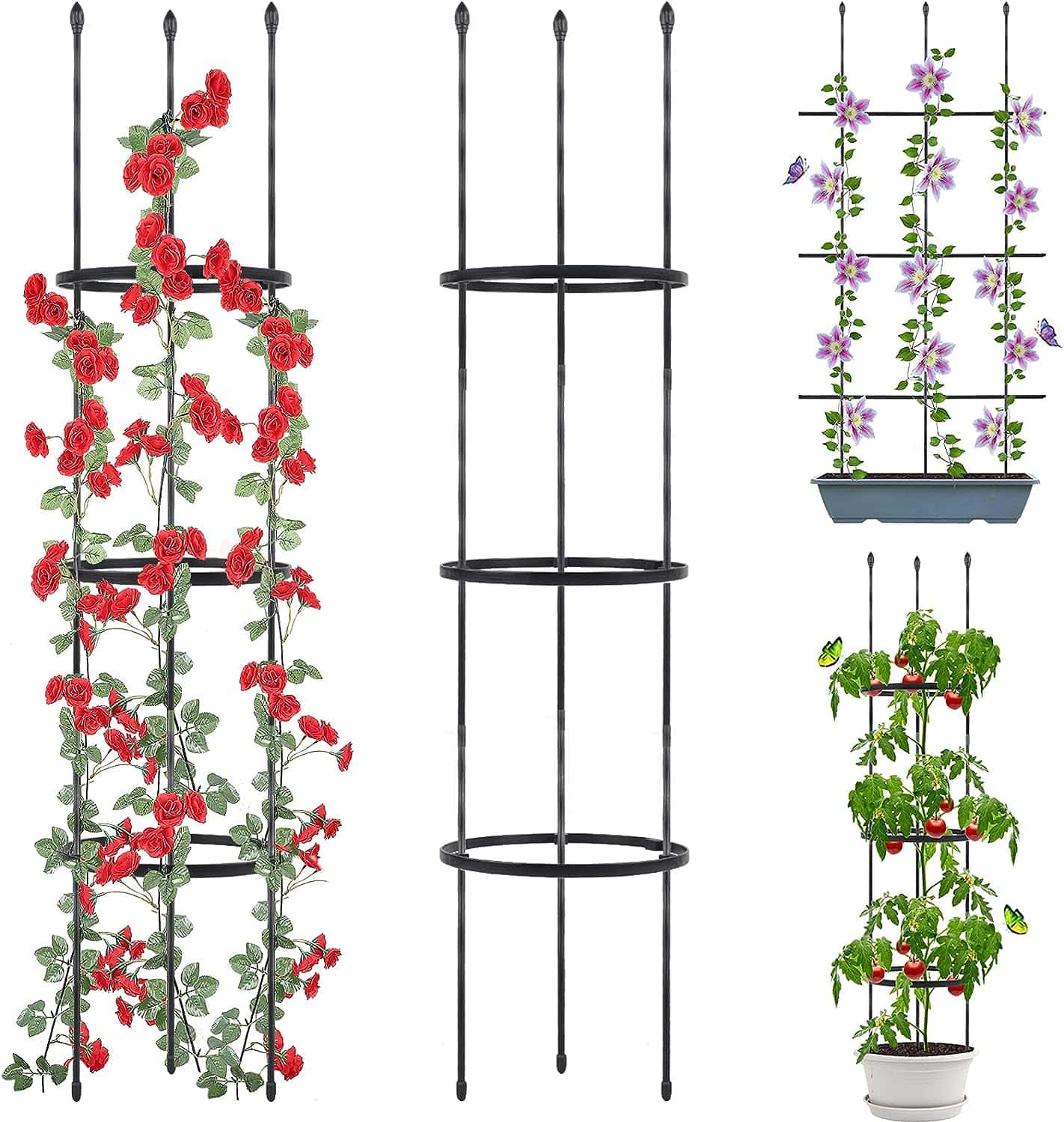Growing grapes in pots is a great way to enjoy fresh grapes even if you have limited outdoor space. With the right setup and care, you can grow healthy grape vines and harvest delicious fruit right from your balcony or patio.
This post may contain affiliate links.
In this article, we’ll cover the basics of growing grapes in pots, including the best types of grapes to grow, the ideal pot size and soil, and tips for pruning and harvesting.
Related Article: How to Prune Grapes: A Beginner’s Guide
First, it’s important to choose the right type of grape for your pot. Look for varieties that are specifically bred for container growing, such as ‘Pixie’, ‘Pinot Meunier’, or ‘Flame’.
These grapes are known for their compact size and adaptability to smaller spaces. You should also consider the climate in your area, as some grapes are better suited to cooler or warmer temperatures.
Related Article: Best Grapes for Red Wine: A Friendly Guide to Top Varieties
Once you’ve chosen your grape variety, the next step is selecting the right pot size and soil. Grapes need plenty of room to grow, so choose a pot that is at least 15 gallons in size.
Make sure the pot has adequate drainage holes and fill it with a well-draining soil mix that is rich in organic matter. With the right setup and care, you can enjoy a bountiful harvest of fresh grapes right from your own home.
Related Article: Growing Grapes on a Trellis
Choosing the Right Grape Varieties
When it comes to growing grapes in pots, choosing the right grape varieties is crucial for the success of your harvest.
There are many different types of grapes available, each with their own unique characteristics and growing requirements. Here are some factors to consider when selecting grape varieties:
1. Climate
The climate in your area plays a significant role in determining which grape varieties will thrive in your pot.
Some grape varieties are better suited for cooler climates, while others require hot and dry conditions to grow. Consider the average temperature, humidity, and rainfall in your area when selecting grape varieties.
2. Purpose
Another important factor to consider is the purpose of your grape harvest. Do you plan to make wine or enjoy fresh table grapes? Wine grapes and table grapes have different growing requirements and characteristics.
Wine grapes, for example, typically have a higher sugar content and lower acidity than table grapes.
Related Article: What to Do With Homegrown Grapes
3. Size
The size of your pot will also impact the grape varieties you can grow. Dwarf grape cultivars are ideal for small pots, while larger pots can accommodate taller vines. Consider the size of your pot and the space you have available when selecting grape varieties.
4. Flavor
Finally, consider the flavor of the grape varieties you are considering. Some popular grape varieties for wine include Cabernet Sauvignon, Chardonnay, and Pinot Noir.
For table grapes, Concord and Thompson Seedless are popular choices. If you are looking for a unique flavor, consider a cross between two grape varieties.
Related Article: Growing Grapes on a Fence
Getting Started with Grapes in Pots
Growing grapes in pots is a great way to enjoy fresh, juicy grapes even if you don’t have a lot of space. Whether you have a small balcony or a large patio, you can grow grapes in pots and enjoy the fruits of your labor. Here’s what you need to know to get started.
Containers
The first thing you need to consider when growing grapes in pots is the container. You’ll need a large container that can hold enough soil to support the grapevine. The optimal container size for growing grapes is at least 15 gallons, but larger containers are even better.
Related Article: Canning Grape Juice
When choosing a pot, make sure it has drainage holes to prevent water from accumulating in the soil and causing root rot. You can also add a layer of gravel or rocks at the bottom of the pot to improve drainage.
Planting Grapes
You can plant grapes in pots using either bare root or cuttings. Bare root plants are dormant and don’t have any soil around their roots, while cuttings are young shoots taken from an existing grapevine.
To plant bare root grapes, soak the roots in water for a few hours before planting. Fill the pot with soil and place the grapevine in the center. Spread the roots out and cover them with soil, leaving the trunk exposed.
For cuttings, plant them in the pot at a 45-degree angle with the bottom end buried in the soil. Water the soil and keep it moist until the cutting develops roots.
Related Article: Canning Grape Jelly
Vine Care
Grapevines need support to grow, so you’ll need to provide a trellis or stake for them to climb. As the vine grows, train it to climb the support structure and prune it regularly to keep it under control.
Grapevines also need plenty of sunlight, so choose a location that gets at least six hours of direct sunlight each day. Water the grapevine regularly, especially during hot, dry weather.
With a little care and attention, you can grow delicious grapes in pots and enjoy the taste of fresh fruit right from your own patio or balcony.
Related Article: Best Soil for Strawberries in Pots
Preparing the Soil
When growing grapes in pots, it is essential to prepare the soil correctly to ensure healthy growth and a bountiful harvest. Here are some steps to follow when preparing your soil:
Start with the Right Soil
Begin by selecting a well-draining potting soil that is rich in organic matter. Avoid using garden soil, as it can become compacted in a pot and prevent proper drainage. You can also add compost to your potting soil to increase its nutrient content.
Related Article: Growing Grapes from Cuttings: A Beginner’s Guide
Check the pH Level
Grapes prefer slightly acidic soil with a pH level between 6.0 and 6.5. You can test the pH level of your soil using a soil testing kit, which is available at most garden centers. If your soil is too alkaline, you can lower the pH level by adding sulfur to the soil.
Add Organic Matter
Adding organic matter to your soil can help improve its structure and increase its water-holding capacity. You can use compost, well-rotted manure, or leaf mold to add organic matter to your soil. Simply mix it into the soil before planting your grapes.
Related Article: Growing Hydrangeas in Pots
Ensure Proper Drainage
Grapes require well-draining soil to prevent waterlogged roots, which can lead to root rot. To ensure proper drainage, add a layer of gravel or sand to the bottom of your pot before adding the soil.
By following these steps, you can prepare your soil for growing grapes in pots. Remember to choose a well-draining potting soil, check the pH level, add organic matter, and ensure proper drainage for healthy and fruitful grape plants.
Training the Vine
Plant the vine in the center of the pot, making sure that the main trunk is straight and the roots are spread out evenly.
Once the vine is planted, it is important to train it to grow in the desired direction. This can be done by attaching the vine to a support system such as a trellis, fence, vertical trellis, arbor, or umbrella using the Kniffen training method.
Related Article: Growing Blackberries in Pots: Tips and Tricks
The Kniffen training method involves training the vine to grow along a central trunk and then training the lateral branches to grow along a horizontal wire. This method is ideal for small spaces and can be used to create a compact and productive vine.
To train the vine using the Kniffen method, start by selecting a main trunk that is straight and sturdy. Attach the trunk to a support system using a soft tie such as twine or plant tape. As the vine grows, remove any lateral shoots that emerge from the base of the vine.
Once the vine reaches the desired height, begin training the lateral branches to grow along a horizontal wire. Attach the branches to the wire using soft ties, making sure that they are spaced evenly and not too close together.
As the vine grows, continue to prune it to maintain its shape and size. Remove any shoots that emerge from the base of the vine and thin out any excessive growth to ensure that the vine receives enough light and air circulation.
By planting and training your grape vine properly, you can enjoy a bountiful harvest of delicious grapes right from your own backyard.
Watering and Fertilizing
Growing grapes in pots requires proper watering and fertilizing to ensure healthy growth and fruit production. Here are some tips to help you keep your grape plants thriving:
Watering
Grape plants need consistent moisture, but they don’t like to sit in water. Overwatering can lead to root rot and other issues. Here are some guidelines for watering your grape plants in pots:
- Water deeply once or twice a week, depending on the weather and soil conditions.
- Use a moisture meter or stick your finger into the soil to check for moisture levels. Water when the top inch of soil feels dry.
- Water slowly and evenly to ensure the water reaches the roots.
- Avoid getting water on the leaves or fruit, as this can lead to disease and rot.
Fertilizing
Grape plants need regular fertilization to provide the nutrients they need for growth and fruit production. Here are some tips for fertilizing your grape plants in pots:
- Use a balanced fertilizer with equal amounts of nitrogen, phosphorus, and potassium.
- Apply fertilizer every 4-6 weeks during the growing season (spring to fall).
- Follow the instructions on the fertilizer package for the correct amount to use.
- Avoid over-fertilizing, as this can lead to excessive growth and poor fruit quality.
- Consider using organic fertilizers, such as compost or manure, to provide a nutrient boost and improve soil health.
- Mulching around the base of the plant can help retain moisture and provide additional nutrients as the mulch decomposes.
Pruning and Maintenance
Pruning is an essential component of growing grapes in pots. It helps to keep the plant healthy and productive. Pruning is usually done in the spring or fall, depending on the type of grapevine you are growing.
The main goal of pruning is to remove any dead or diseased wood, as well as to shape the plant to promote healthy growth.
When pruning grapes, it is important to focus on the canes and the main trunk. The canes should be pruned back to two to three buds to promote new growth. The main trunk should be pruned to remove any dead or diseased wood and to shape the plant.
Maintenance is also an important aspect of growing grapes in pots. It involves regular watering, fertilizing, and pest control. Grapevines require consistent watering, especially during the growing season.
Fertilizing should be done in the spring and fall to provide the plant with the necessary nutrients. Pest control should also be done regularly to prevent any damage to the plant.
Pest and Disease Control
Growing grapes in pots requires careful attention to pest and disease control. Here are some tips to help you keep your grape plants healthy:
Pests
Pests can be a major problem for grape plants. Japanese beetles, birds, and aphids are some of the most common pests that you may encounter.
Japanese beetles can be controlled by handpicking them off your plants or using a pesticide. Birds can be deterred by using netting or reflective tape. Aphids can be controlled with a soap solution or insecticide.
Disease
Disease can also be a major problem for grape plants. Fungus and rot are two of the most common diseases that you may encounter.
Black rot, mildew, powdery mildew, and downy mildew are some of the most common types of fungus that can affect grape plants. Anthracnose is another disease that can affect grape plants. To prevent disease, make sure your plants have good air circulation and are not overcrowded.
Prevention
Prevention is key when it comes to pest and disease control. Make sure to keep your plants healthy by providing them with adequate water, nutrients, and sunlight.
Regularly inspect your plants for signs of pests or disease, and take action as soon as you notice any problems. By following these tips, you can help ensure that your grape plants stay healthy and productive.
Harvesting and Overwintering
Once your grapes have ripened, it’s time to harvest them. Grapes are ready to be harvested when they are fully colored and have a slight softness to them.
To harvest, simply cut the grape clusters from the vine using a sharp pair of pruning shears. Be sure to leave a small stem attached to the cluster.
After harvesting, it’s important to properly store your grapes. If you plan on consuming them right away, you can keep them in the refrigerator for up to a week. If you want to store them for longer, you can freeze them or make them into juice or jam.
Overwintering your grape plant is crucial to ensure it survives the winter months. If you live in a region with harsh winters, it’s recommended to bring your container-grown grape plant indoors.
Place it in a cool, dark area such as a basement or garage. Be sure to water it sparingly throughout the winter months.
If you live in a milder climate, you can leave your grape plant outside. Be sure to mulch around the base of the plant to protect the roots from freezing temperatures.
Water the plant sparingly throughout the winter months, making sure not to overwater.
Overall, harvesting and overwintering your container-grown grapes is relatively easy as long as you follow these simple steps. With proper care, you can enjoy delicious fruit from your grape plant for years to come.
Frequently Asked Questions
What are the best grape varieties to grow in containers?
When it comes to growing grapes in containers, you want to choose varieties that are well-suited for small spaces.
Some of the best grape varieties for container growing include Flame Seedless, Thompson Seedless, and Black Monukka. These varieties are known for their compact growth habits and ability to produce fruit in small spaces.
How do you prepare soil for growing grapes in pots?
To prepare soil for growing grapes in pots, you should use a high-quality potting mix that is rich in organic matter. You can also add some perlite or vermiculite to improve drainage. Before planting, make sure to moisten the soil thoroughly.
What size container is needed for growing grapes?
The size of the container you need for growing grapes will depend on the variety you choose and the space you have available. I
n general, you should use a container that is at least 18 inches in diameter and 18 inches deep. Larger containers will provide more room for the roots to grow and produce a larger harvest.
Can grapes be grown in small spaces?
Yes, grapes can be grown in small spaces, as long as you choose the right varieties and provide them with the proper care. Container-grown grapes are an excellent option for small gardens, patios, and balconies.
What are the steps to grow grapes from cuttings?
To grow grapes from cuttings, start by selecting a healthy stem that is at least 6 inches long and has several buds. Remove the leaves from the bottom half of the stem, and dip the cut end in rooting hormone.
Plant the cutting in a pot filled with moist potting mix, and keep it in a warm, bright location. Water the cutting regularly, and it should start to produce roots within a few weeks.
How do you overwinter potted grapes?
To overwinter potted grapes, move the container to a cool, dark location, such as an unheated garage or basement. Water the plant sparingly, and do not fertilize during the winter months. In the spring, move the container back outside and resume regular watering and fertilization.






